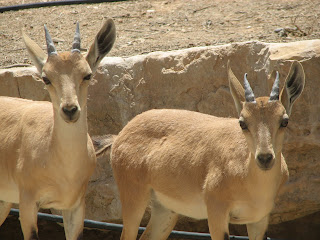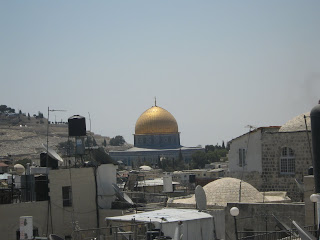The first stop of the day was the one I was the most excited about for the whole Galilee trip. The prospect of a boat ride on the Sea of Galilee just sounded like so much fun! I’ll even admit that I was secretly hoping that a storm would suddenly blow in so we could experience a taste of what the disciples felt. Then we were told that storms have caused waves as high as ten meters on the Sea of Galilee. I can live without experiencing waves that high on a body of water that small!
The boat ride was indeed a blast, and the boat was actually bigger and nicer than I expected. The highlight of the boat ride for me was when one of the men from the crew demonstrated the use of a castnet. The net he used was similar to what would have been used in the first century, but it was made out of different material. Instead of being made of rope for the net and stones for the weights, it was made of nylon for the net and metal weights. It was still interesting though.
The location we docked at is the home of the Jesus Boat. This is a boat that was discovered less than 30 years ago. It seems to be from the first century, and is remarkably intact. This is the kind of boat that Jesus and the disciples would have used on the Sea of Galilee. My only disappointment in the exhibit was that they didn’t spend much time discussing how they preserved the boat. It soaked in a pool of chemicals for years, but I really wanted to know what kinds of chemicals. This is something I’ll have to look up later. The way the boat was displayed was absolutely stunning. I really enjoyed the way they used sandblasted pieces of glass cut in wavy patterns to mimic water. The blue lighting really enhanced the effect. It was a very creative and well done exhibit. I just wish I had thought to bring a tripod on this trip just so that I could have gotten a decent picture of the boat and exhibit. Oh well, live and learn.

The Jesus Boat. I had to use a flash so the picture is very washed out. The actual exhibit is much, much prettier
Next on the agenda was a visit to two different churches. This is really what I needed at this point in the trip. We first went to a church that celebrates the miracle of Jesus feeding the 5,000. The church was one of the most peaceful I’ve ever visited. The church had some beautiful mosaics that were a joy to view. It was a great place just to spend a few minutes in prayer.
We then moved on to the church that commemorates (and claims to be the location of) Jesus giving the Beatitudes. The sisters there had reserved us a location where we were able to have a short worship service. We sang a few songs, and then McKenzie shared with us a few thoughts on the Beatitudes and visiting the Holy Land in general. We were then given 45 minutes to wander around the grounds of the church as well as the church itself. This came when I needed it most. This trip is very intensive and tiring, and the focus is mainly on academics. Even though we get a handful of free days or afternoons, we have to spend most of them studying for our exams and doing map work. The 45 minutes we had at this location gave me a time when all we had to do was enjoy the gardens and spend time in prayer and contemplation. Up until this point, I had been getting more and more worn out and the trip was starting to be a chore rather than a joy. This little bit of time given to us helped me to refocus my priorities for the rest of the trip. I only wish we had gotten a chance to experience this sooner.
The best part about the visit to Chorazim was that there were a bunch of rock hyraxes there. I’ll take a moment to admit that I have no idea what the plural of hyrax is. Anywho, there were a bunch of them and I was able to not only see them in the wild but also get a few pictures of them. This was incredibly exciting for me because the one animal I really wanted to see in Israel was a rock hyrax. Not only did I see one of them, I got to see a bunch. They were everywhere!
The last stop of the day was the cliffs of Arbel. We had tried to stop here on our first day, but we were just late enough getting there that we weren’t able to see it then. We hiked over to the top of one of the cliffs to discuss what we could see and to admire the view. I say we walked over because we were already nearly to the top of the cliff when we parked the bus. The hike the rest of the way to the top was short and the ascent was minimal. Then we were given the option to walk back to the bus or to take an hour long hike.
I opted for the hike. I was smart enough to take two liters of water with me. This ended up being a very good thing, even though it made my backpack heavier than I would have liked. The hike down was fairly steep with us having to climb down small metal rungs at times. Part of me kept thinking that this was crazy. Thankfully, I continued on. By the time we finished our descent, I had already torn through liter number one of water and was wishing I had brought three liters with me instead of just two. It didn’t help that it was 40°C (104°F). If I had known it was this hot, I might have opted to go back to the bus rather than hike. Thankfully, there was a bit of somewhat flat ground to walk on for a while, which was a nice break from climbing down. There were all kinds of caves that Jewish men hid in at one point when they were defying Herod. They were pretty interesting to see. Finally we came to the point where we needed to start climbing back up the cliff.
This was the part I had been dreading. Initially, we had a fairly steep hike up that was longer than I expected. Then we came to the point where hiking up a nice trail was no longer really an option. It was time to start climbing back up the cliff. Thankfully, the park service is kind enough to put in big metal rungs and cables that you can hang onto and step on (in the case of the rungs that is). If the climb had been much steeper or if those rungs hadn’t been there, I would have been looking for a harness and climbing rope. Overall, the climb back up wasn’t too terrible. At least it wouldn’t have been if it hadn’t been so hot outside. By the time I made it back to the bus, I had consumed all the water I had and was wishing we hadn’t already used up the rest of the water on the bus. I was very thankful to get back to En Gev and get more water.
The capstone to the whole day was getting back to the resort at En Gev earlier than we expected. This was great because it meant we had time to change into our swimsuits and go swimming in the Sea of Galilee for a while before supper. After hiking in 104°F temperatures, swimming in the cool, calm water of the Sea of Galilee felt amazing. I had initially planned to go swimming again after supper, but the post-Arbel swim was so wonderful that swimming again would have just been disappointing.
The final event of the day was a worship service on the shore of the Sea of Galilee that Dr. Richter had put together. Dr. Stone and Laurie White took turns leading us in some songs. In between these, several people shared testimonies of how God is working in their lives, or epiphanies and insights God had given them during this trip. It was a great time of worship and praise, and really helped to sum up our trip thus far. I walked away from that service thinking that if we had ended the trip right then and there, I would feel like this trip had been worth it. Everything else to come is just icing on the cake.






































